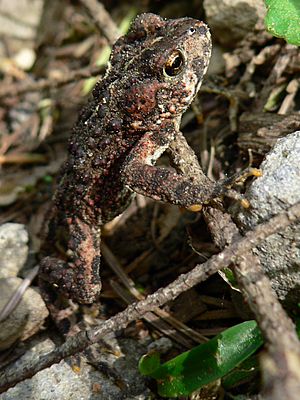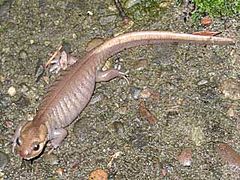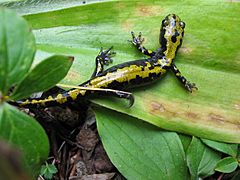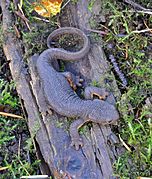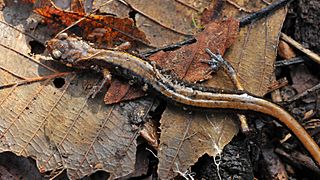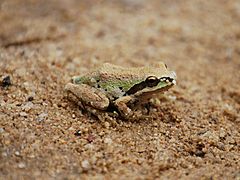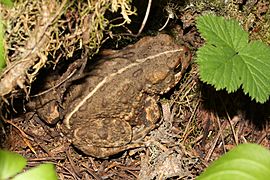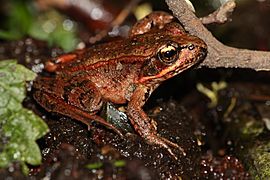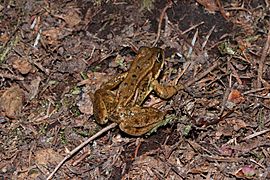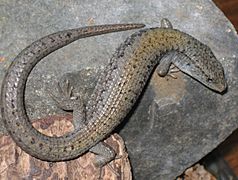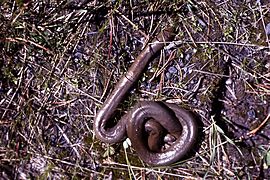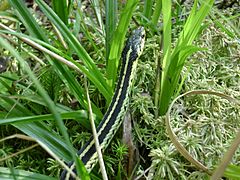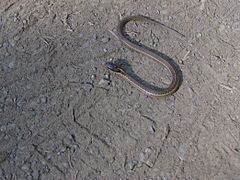List of amphibians and reptiles of Olympic National Park facts for kids
Olympic National Park is a special place! It's home to many amazing animals, including 13 types of amphibians and four kinds of reptiles. Amphibians are creatures like frogs and salamanders. They can live both in water and on land. Reptiles are animals like lizards and snakes. They usually have scales and lay eggs. All these cool creatures are part of the wildlife found in Washington state. You can learn more about them from the Burke Museum of Natural History and Culture at the University of Washington.
Contents
Amphibians
Amphibians are fascinating animals that often start their lives in water and then move to land as they grow. Olympic National Park has many different kinds of amphibians, from tiny frogs to large salamanders.
Northwestern salamander
The northwestern salamander (Ambystoma gracile) lives along the Pacific coast of North America. These salamanders can grow quite large, up to 8.7 inches (220 mm) long. You can find them from southeastern Alaska all the way down to California. They live from sea level up to the tree line, but not east of the Cascade Range.
Long-toed salamander
The long-toed salamander (Ambystoma macrodactylum) is a type of mole salamander. It's usually about 1.6 to 3.5 inches (4.1–8.9 cm) long when it's fully grown. This salamander has cool black, brown, and yellow patterns. It also has a really long fourth toe on its back feet!
These salamanders live mostly in the Pacific Northwest. They can be found in many different places, from wet rainforests to dry sagebrush plains. They also live near slow-moving streams, ponds, and lakes when they are breeding. During the cold winter, they hibernate (sleep deeply) and use energy stored in their skin and tail.
Olympic torrent salamander
The Olympic torrent salamander (Rhyacotriton olympicus) is a small salamander, growing up to 4 inches (10 cm) long. It loves clear, cold mountain streams. This salamander is special because it's only found in the Olympic Mountains of Washington. Its home is in cool forests, rivers, and freshwater springs.
Cope's giant salamander
Cope's giant salamander (Dicamptodon copei) is a unique salamander. It grows to be about 4.9 to 7.5 inches (12.4–19.1 cm) long. This salamander looks like a young Pacific Giant Salamander. But the cool thing is, it never changes into a land-dwelling adult! It stays in its water form its whole life. It's usually brown with yellowish-tan spots and a dark bluish-gray belly.
Rough-skinned newt
The rough-skinned newt (Taricha granulosa) is famous for its strong poison. This newt lives all along the West Coast of the United States and British Columbia. You can find them from Santa Cruz, California, all the way up to Alaska.
Oregon ensatina
The Oregon ensatina (Ensatina eschscholtzii oregonensis) is a type of lungless salamander. This means it breathes through its skin! You can find them in forests and woodlands from British Columbia down through Washington, Oregon, and California, all the way to Mexico.
Western redback salamander
The western redback salamander (Plethodon vehiculum) lives in Canada and the United States. Its favorite places are temperate forests and rocky areas. This salamander has a cool stripe on its back that can change color from red to yellow!
Van Dyke's salamander
Van Dyke's Salamander (Plethodon vandykei) is another type of lungless salamander. It is found mostly in the western part of Washington, northern Idaho, and northwestern Montana. You'll usually find it in hilly or mountainous areas like the Olympic Hills and the Cascade Mountains.
Pacific tree frog
The Pacific tree frog (Pseudacris regilla) is a very common and well-known frog. It lives all along the West Coast of the United States, from California up to British Columbia in Canada. These frogs can live almost anywhere, from sea level up to over 10,000 feet high! They can be green or brown and can even change colors. They live in many different places and lay their eggs in water. This frog is also called the Pacific chorus frog.
Coastal tailed frog
The tailed frogs are two special kinds of frogs. The "tail" you see on the male frog is actually a part of its body used for reproduction. This "tail" helps them live in fast-flowing streams. It's the only frog in North America that reproduces by internal fertilization. Until 2001, people thought there was only one type of tailed frog. But now we know there are two: the coastal tailed frog (Ascaphus truei) and the Rocky Mountain tailed frog.
Western toad
The western toad or boreal toad (Bufo boreas) is a large toad found in western North America. It can be between 2.2 and 5.1 inches (5.6 and 13 cm) long. It has a white or cream stripe down its back. Its skin is usually dusky gray or greenish with dark spots where its glands are.
Northern red-legged frog
The northern red-legged frog (Rana aurora) lives along the coast from southwest British Columbia down to Northern California. This frog is protected in British Columbia, Oregon, and California.
Cascades frog
The Cascades frog (Rana cascadae) is a type of frog found in the western United States and possibly Canada. You'll mostly find it in the Cascade Range and Olympic Mountains.
Reptiles
Reptiles are amazing creatures that are usually covered in scales. They are often found basking in the sun to warm up. Olympic National Park is home to several cool reptile species.
Northern alligator lizard
The northern alligator lizard (Elgaria coerulea) is a medium-sized lizard found on the North American west coast. These lizards are slender and can grow to about 10 inches (25 cm) long, including their tail. They have a special skin fold on their sides. Their backs have rough scales, while their bellies are smooth and light gray. They are brownish and often have dark blotches that can look like bands. Their eyes are dark. You can find them from southern British Columbia down through Washington, Oregon, and California, and even into parts of Idaho and Montana.
Rubber boa
The rubber boa (Charina bottae) is a unique snake. It belongs to the Boidae family, which includes non-venomous snakes like boas. The rubber boa is one of four species in its genus, with three found in North America. It gets its name because its skin feels soft and rubbery!
Common garter snake
The Puget Sound garter snake (Thamnophis sirtalis pickeringii) is a type of common garter snake found near the Puget Sound. Most garter snakes have yellow stripes on a brown background. They usually grow to be about 3 to 5 feet (1 to 1.5 meters) long. The common garter snake is active during the day. In summer, it's most active in the morning and late afternoon. When it's cooler, it likes to be out during the warm afternoons.
Northwestern garter snake
The northwestern garter snake (Thamnophis ordinoides) is a small garter snake. Adults are usually around 14 to 21 inches long. This snake is known for having many different color patterns, making each one look a bit unique! You can find it in Oregon, Washington, California, and British Columbia. These snakes often live at the edge of meadows surrounded by forests, where they can get enough sunshine to stay warm.
See also
- Mammals of Olympic National Park


